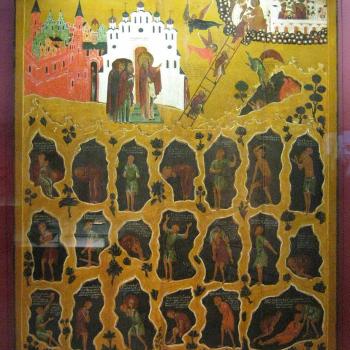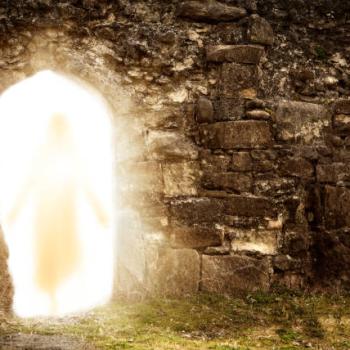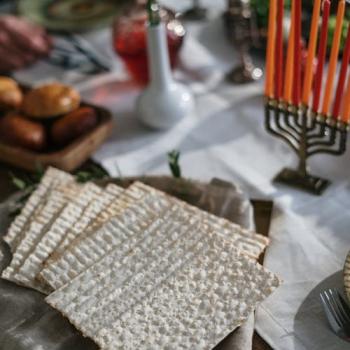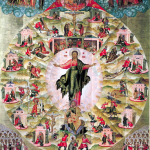
Mark crams a lot into Wednesday of Holy Week – or is it Wednesday plus part of Thursday. It’s hard to tell. There’s a long speech that sounds like Jesus talking about the end of the world, but maybe it’s about world-shaking events of any age, including ours. The community that Mark wrote for also knew a shaking of worlds. In the year 70 Rome captured Jerusalem from Jewish rebels and destroyed the Temple. Maybe that’s what Wednesday’s speech was about. Interesting to speculate, but my favorite part of Wednesday feels a lot better. During supper at the house of Simon the Leper, a woman administers to Jesus what I call a sacrament of touch.
Some people are auditory learners, some visual. Some, like me, relate to the world mainly through the sense of touch. That sense turns out to be important for Jesus’ story as Mark tells it.
Mark’s is the darkest of the four Gospels. Jesus is constantly beset by enemies. His friends and disciples don’t understand him, not even his mother, brothers, and sisters. A lonely exception is a woman whose name we don’t know. She will cause consternation among some guests at Simon’s house. One in particular, a practical-minded soul, decides he’s had enough of following Jesus.
A jar of perfume and a loving touch
The Feast of Passover approaches, and Jesus retires from the tumult in Jerusalem to the Simon the Leper’s home in Bethany. It’s a place from which Jesus’ enemies, worrying about ritual purity and a leprous touch, would keep their distance.
The crowd here isn’t entirely friendly. A woman comes with a jar of perfume to do a sacred action, a sacrament. She pours the expensive fragrant oil on Jesus’ head and, with delicate touch, massages it into his hair and scalp. Some watchers are indignant at the waste of money, not to mention the boldness of this strange woman. The money that the woman has wasted could be feeding many poor people. Jesus praises the woman: “She has anticipated anointing my body for burial.” (Mark 14:3-9)
This is a story of a true disciple, rare in Mark’s Gospel. The woman has not been following Jesus like those of the community of disciples. But, in fact, she is going where the male disciples can’t. She is anointing Jesus’ body for burial, a sacrament the others can’t perform, a thought they can’t accept – but she can.
We feel the touch of the unnamed woman’s hands on Jesus’ head. Bible scholar Ched Myers comments: Her “care for Jesus’ body narratively prepares us for the emergence of this body as the new symbolic center of the community.” (Binding the Strongman, p. 359)
But the disciples have not moved away from the Temple as the center of their world. One disciple in particular chooses Temple over a very mortal body: “Then Judas Iscariot, one of the Twelve, went off to the chief priests to hand him over to them.” (Mark 14:10) I see here a serious wound in the line of succession leading out from Jesus but no hint of the traditional idea that Judas was coveting that money.
A world of healing touches
A line of succession is what Jesus needs – disciples to carry on his mission after he is gone. It will not be according to the human pattern of men (or women) descendants taking up the mantle for the next generations. Nor will it be like students following to the letter the teaching of a great master of long ago. It has to be the same community that gathered, with all its faults, around Jesus – the ones Jesus touched or who touched Jesus. Like the children who felt Jesus’ friendly touch even as the disciples objected. Like the woman who experienced healing as she touched the hem of Jesus’ cloak.
Discipleship does not center on Jesus’ teaching and not on the practices he calls us to, not even when that means taking up his cross. It is Jesus’ body at the center, touching and being touched by many. Jesus’ community needs to be always in touch with Jesus’ body through a succession of touches.
I don’t know the precise working of what’s called “apostolic succession.” That Catholic teaching imagines a long line of bishops consecrating bishops with a sacred sign supposedly all the way back to the apostles. What matters to me is that I touch Jesus, directly and indirectly.
Directly, I touch Jesus in the Sacrament of the Eucharist. Indirectly, another sacrament brings Jesus’ touch to me. A line of disciples runs from the ones Jesus touched to the ones who birthed and parented me. Dave and Rose Marie, like many others of my forebears, felt Jesus’ healing touch in daily life and sacrament. In their flesh, wounded by sin, they became the sacrament of Jesus’ healing touch for their world and for me.
(This posted is adapted from a series that I called “The Worldly Spirituality of the Gospel of Mark.” If interested, this link will take you to the first in the series and a table of contents.)

















